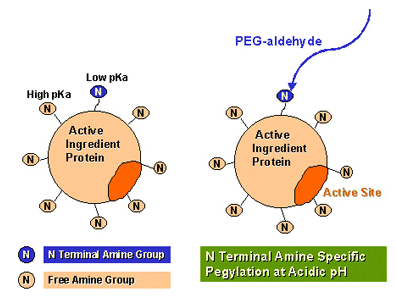

PEG PRODUCTS

PEGylation Chemistry Info
PEGylation Chemistry Info

-
PEG can be attached to the N-terminal amino group of proteins and peptides. This is called N-terminal pegylation.
The N-terminal pegylation may allow advantage in purification of the conjugates. It is also believed that the N-terminal pegylation may better preserve bioactivity as compared to a random pegylation of amino group of lysine residues.
The agents used in achieving the N-terminal specific Pegylation are PEG-aldehydes. This is facilitated by the difference in pKa values of the amino group of lysines( ~10) and of amino group of N-terminal amino acid(~7.6- 8.0), which allows pH dependent nucleophilic attacks to the electrophilic
PEG-aldehydes. SunBio has recently developed novel mPEG-aldehydes especially for the N-terminal specific pegylation.
N-terminal pegylation may be conducted, for example, in 100 mM sodium acetate or 100 mM sodium biphosphate buffer at pH 5.0~6.0. The buffer may additionally contain 20 mM sodium cyanoborahydride. The molar ratio of compound to mPEG-aldehyde may be 1:5 ~ 1:10. The pegylation is then stirred overnight at ambient or refrigeration temperature.
-
Example 1 :
PEG-aldehyde PEG-aldehyde may pegylate N-terminal amino group of peptides and proteins. The reaction pH is important for the N-terminal amine specific pegylation and the pH may be at around pH 5.
-
Example 2 :
PEG-propionaldehyde SunBio has developed several novel PEG-propionaldehydes to overcome the relatively nonspecific and weak
N-terminal pegylation of PEG-aldehyde.
-
Example 3 :
PEG-butylaldehyde SunBio has developed several novel PEG-butylaldehyde that can also be useful for N-terminal pegylation.






 PEG PRODUCTS
PEG PRODUCTS